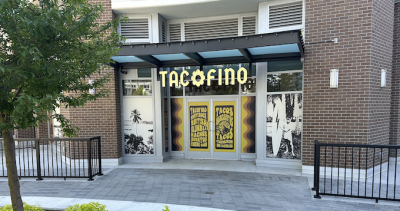Danza Cuba returns to Canada
For most of us, Cuban dance is showgirls in feathered headdresses cha-cha-ing at the Tropicana or the sweaty couplings in the underground salsa clubs of Havana’s Miramar district. Lizt Alfonso Danza Cuba, the biggest dance troupe to come out of the country, explodes all those preconceptions.
Its shows on Wednesday and Thursday (April 23 and 24) at North Van’s Centennial Theatre will be elegant showcases not only for razor-sharp precision and technical prowess, but for the kind of surprising hybrids that can happen in the island state’s unique cultural hothouse. Classical ballet, Afro-Cuban dance, folk, and especially flamenco meld seamlessly into a new form in Danza Cuba’s theatrical, synchronized pieces for 18 female dancers backed by six live musicians.
“We might do a pirouette from classical ballet, but during that pirouette, the movement of the hips maybe comes from the Cuban rumba, and the movement from the shoulders and the head come from flamenco. It’s complicated to do but for us it’s easy now,” explains the warm and lively Lizt Alfonso, who runs her 17-year-old company and school out of one of Old Havana’s grandly picturesque historical buildings. Reached by phone at a theatre in Rimouski, Quebec, she is travelling with her troupe in the midst of a 20-city cross-Canada tour called Fuerza y Compás (“strength and rhythm”). “Good training is very important, with all the different styles of dance, which are very complicated. You have to have impressive skill to do everything. For this reason I do my own school, so I can teach them all the differences of the dances first, before we make the fusion.”
For Alfonso, that fusion came naturally—and early. As a young child, she started with ballet, but by 11 was already delving into flamenco as well. Eventually she began studying the latter form with professors from not only Spain but Cuba, Brazil, and elsewhere in the Latin world. So the flamenco that works its way into Danza Cuba’s show is a not a straight-up version of the stamping feet and clacking castanets that you might see in the tabernas of Andalusia. “The pure, pure flamenco is very difficult to do. I believe flamenco is a philosophy of life, so only the people born in Spain can do the pure form; for foreign people it’s very difficult. So we learn a different kind of flamenco here,” she says.
The other influences—the rumbas, the boleros, the cha-chas—were all around her. And what of her unique fusion’s famous perfectionism? The artist laughingly admits it comes straight from her: “It’s one of my good things and one of my bad things.”
Over the years, Alfonso’s school, called Ballet Lizt Alfonso, has grown to take in 900 students. The facility is a rarity in Cuba in that it is not a national institution, but runs independently—albeit with funding from the government. At the same time, its shows, with their big group numbers and wildly colourful costumes, can sell out Havana’s 5,000-seat Karl Marx Theatre.
By 2003, the company had also become a draw in the U.S., but its links there suddenly collapsed when George W. Bush banned Cuban arts groups. “The last time we went to the U.S. we showed on Broadway. It was a big success and everybody was happy at that moment. But from that same moment, they didn’t give out visas again,” Alfonso says. “To me, one thing is art, and one is politics, and they don’t match very well. Why can some person decide that people in the U.S. can’t see the company again? People love the company. Many Americans come to Canada to see us if we are near the U.S. [border].”
The Canadian connection, which developed after the U.S. ban, has been a boon to the company. Last year, Danza Cuba hooked up with Mirvish Productions and helped create a new musical called Vida!, featuring legendary Buena Vista Social Club member Omara Portuondo. Hot off the success of that show, it set up this year’s tour. The program spans everything from Riverdance-like chorus lines of women in fitted black pants and puffy blouses putting a contemporary twist on flamenco, to castanet-clacking dancers in ruffled red Spanish dresses sparring with those in traditional white country-style frocks.
“It’s fantastic because Canadians are very open-minded people,” Alfonso says. “It’s very hard work for everybody but the result has been very good, because until now everybody has given us a standing ovation at each show across Canada, and it’s very difficult to receive these kinds of emotions from people in Canada.”
And what’s it been like travelling mostly by bus from one end of the country to the other—with an all-female ensemble? “Yes, it’s so many women! But we’ve known each other such a long time,” Alfonso says with a laugh. “From our school in Havana, I’ve known them when they were four or five or six years old. So it is very easy—it’s like a big family.”















Comments